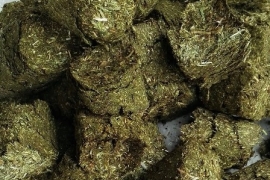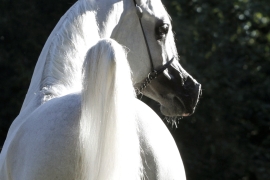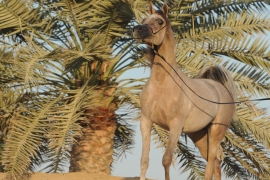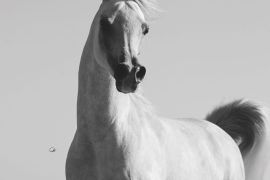Continuing from my last newsletter on the theme of what became of various foal crops of the past, let's look into the "Class of 1958" in Egypt and see what horses were born that year and what became of them?
In my previous newsletter about the class of 1956 I pointed out the irony of Nazeer being one of the most heavily used sires in 1956 yet only two of his get would be used for breeding, Morafic and Alaa El Din. We all know how that turned out. These two sons alone could have put Nazeer on the world map of Arabian horses for decades. In 1956 the EAO managed to produce 32 foals but as world politics and economics continued to vary, only 26 foals were produced at the EAO in 1958. Interestingly that same year a young and enthusiastic couple from America met and married in Turkey and began their adventures throughout the Middle East which would eventually bring them to visit the EAO. That couple was Don and Judi Forbis. Another American had already visited the EAO in 1956 in search of more Arabian bloodlines to go with his foundation mare and that American was Richard Pritzlaff. His 5 EAO purchases were put aboard ship in 1958 and arrived in America bearing the first of Nazeer blood to reach US shores. Europeans were also visiting the EAO so clearly there was a growing interest in the Arabians being produced there and one name was considered a main attraction and that was Nazeer.
%20from%20the%20class%20of%2058.jpg)
Three famous Nazeer yearlings born in 1958 among the "year of Nazeer"
who would become influential world-wide, left to right,
Ansata Ibn Halima, Ansata Bint Mabrouka and Ansata Bint Zaafarana
Looking back at the foals born at the EAO, without a doubt 1958 was Nazeer's year. He was the sire of 19 colts and fillies, and there were even already 4 grandget of Nazeer produced. The other sires had to be content with only one or two each, with Gassir being the sire of 2, Badr the sire of 1, Sameh the sire of 1, and Mashhour the sire of 1 foal. Some horses from the disbanded Inshass stud were being bred nearby the EAO facility under supervision and this resulted in two foals sired by the Inshass stallion Abboud, one of which, a filly named Wedad, would go on to establish a respected family in Europe based on her daughter Bint Wedad (Hassan x Wedad) who had 15 foals, most in Europe and later in Israel.
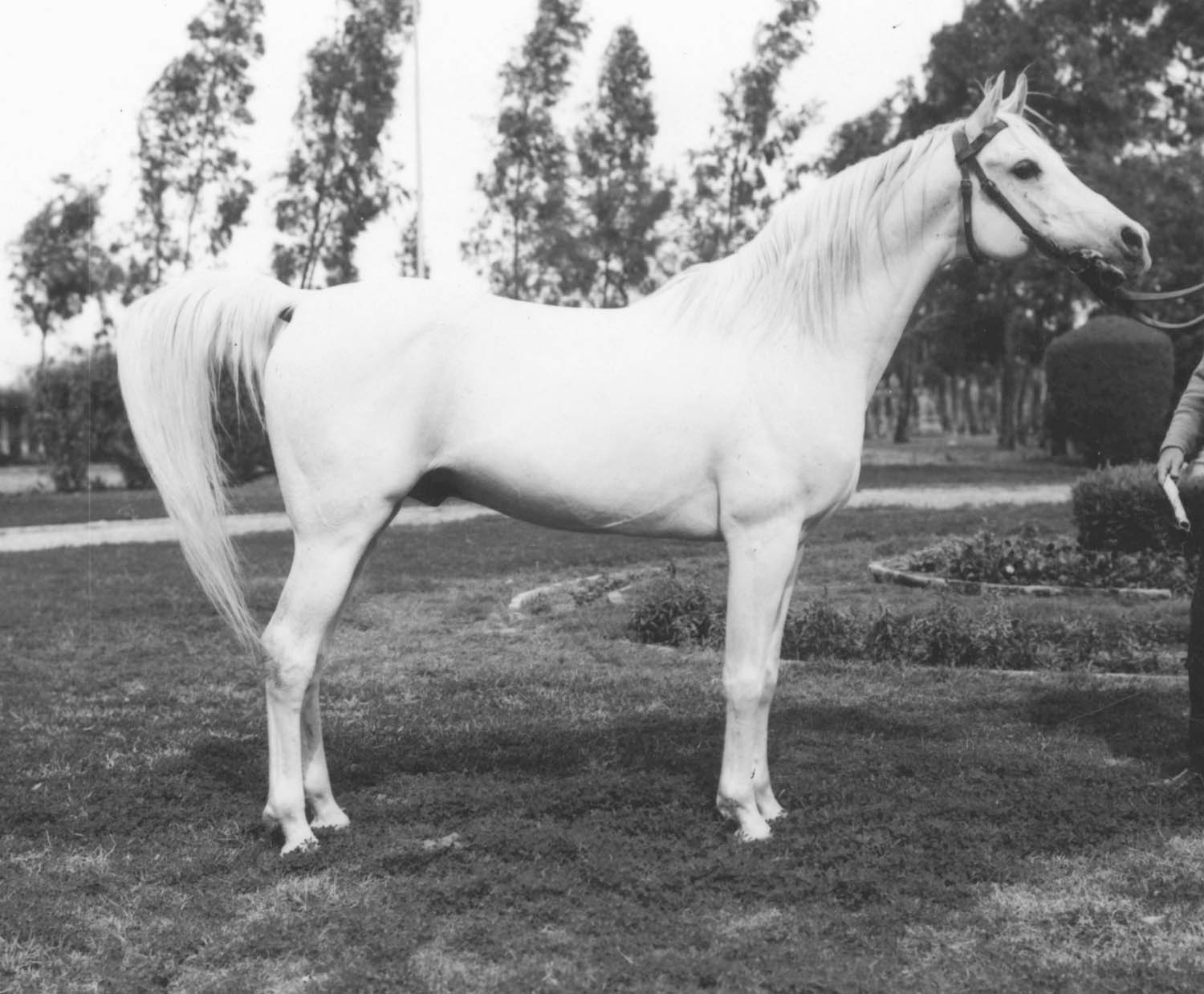
Ramses Fayek, (Nazeer x Fayza II)
known as Fayek in Egypt was the first-born son of Nazeer in 1958.
He would become a much admired sire of champions.
Forbis photo.
So what became of the Nazeer get from the class of 1958? Of his 10 sons, 6 would be used for breeding and their names read like a "hall of fame" list now. The first born Nazeer son that year was none other than the very handsome Ramses Fayek (x Fayza II) known as Fayek in Egypt. First an important sire for renowned AlBadeia Stud, Ramses Fayek was later imported to the U.S. by Martin Loeber who gave him a great opportunity at stud resulting in a number of National Champions and other admired show winners descending from him.
Nazeer's next sire of note from the class of 1958 was Waseem (x Malaka) who was also an important sire for AlBadeia Stud. Among his most famous is the lovely Malekat El Gamal, whose granddaughter, Sundar Alisayyah produced the incomparable Al Adeed Al Shaqab.
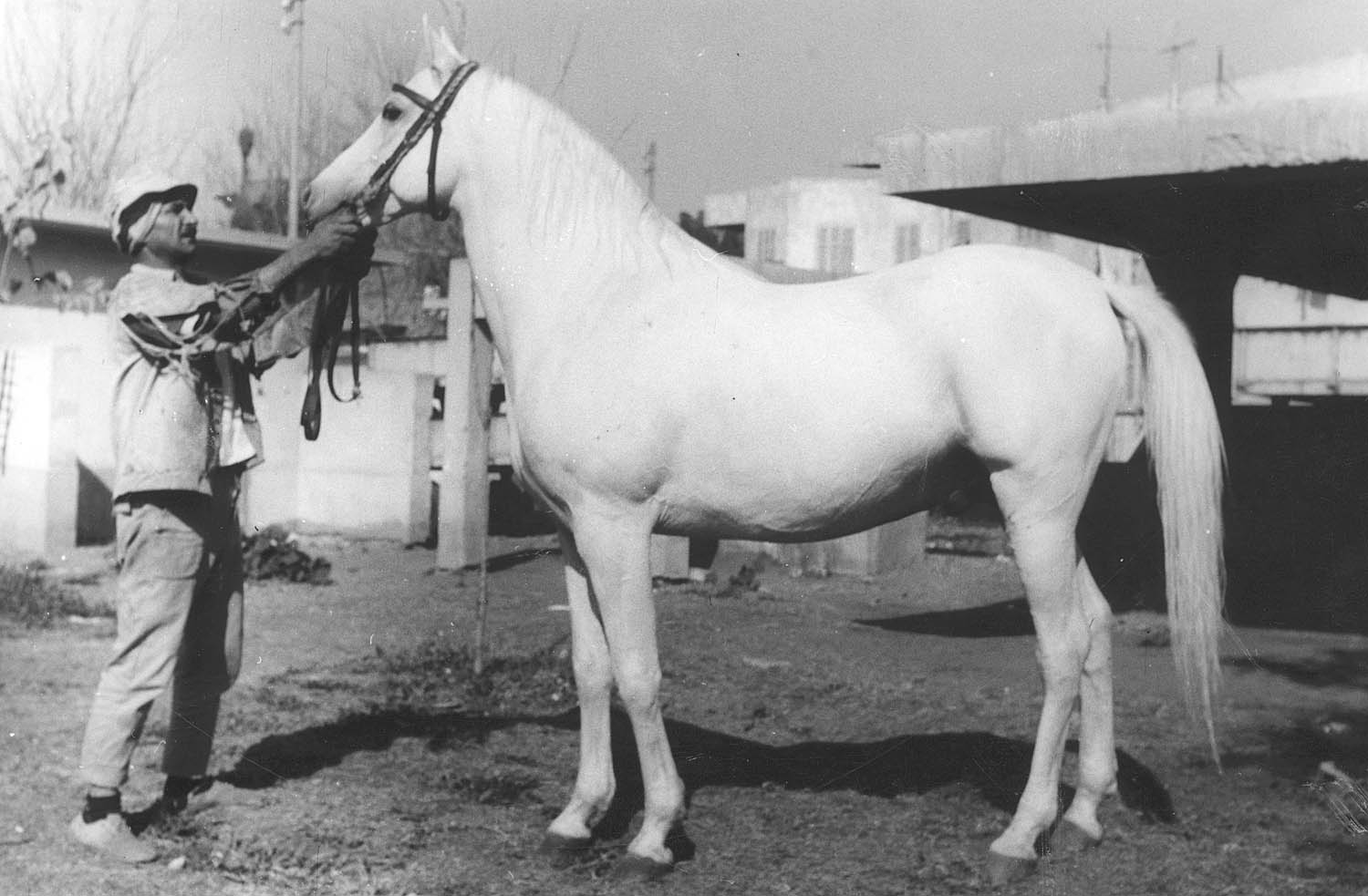
Waseem, (Nazeer x Malaka) an important founding sire
for AlBadeia Stud and sire of the beautiful Malekat El Gamal.
Forbis photo.
Just 3 days after Waseem was born, another fine grey colt was foaled with particular class and style. He would become a political gift from Egypt to Russia for its financial and construction support in building the great Aswan dam in Egypt. The dam gave Egypt resources for much needed economic improvement and this colt, who was born as Rafaat but later renamed Aswan, became a symbol of the great dam. He was out of the splendid producing mare Yosreia and the success of this cross would be repeated 5 times at the EAO. Aswan would become one of the largest patriarchies in the Arabian breed, without ever having left any legacy within straight Egyptian bloodlines. In Russia he would leave many sons and daughters which would make there way into the vast majority of Arabian bloodlines today.
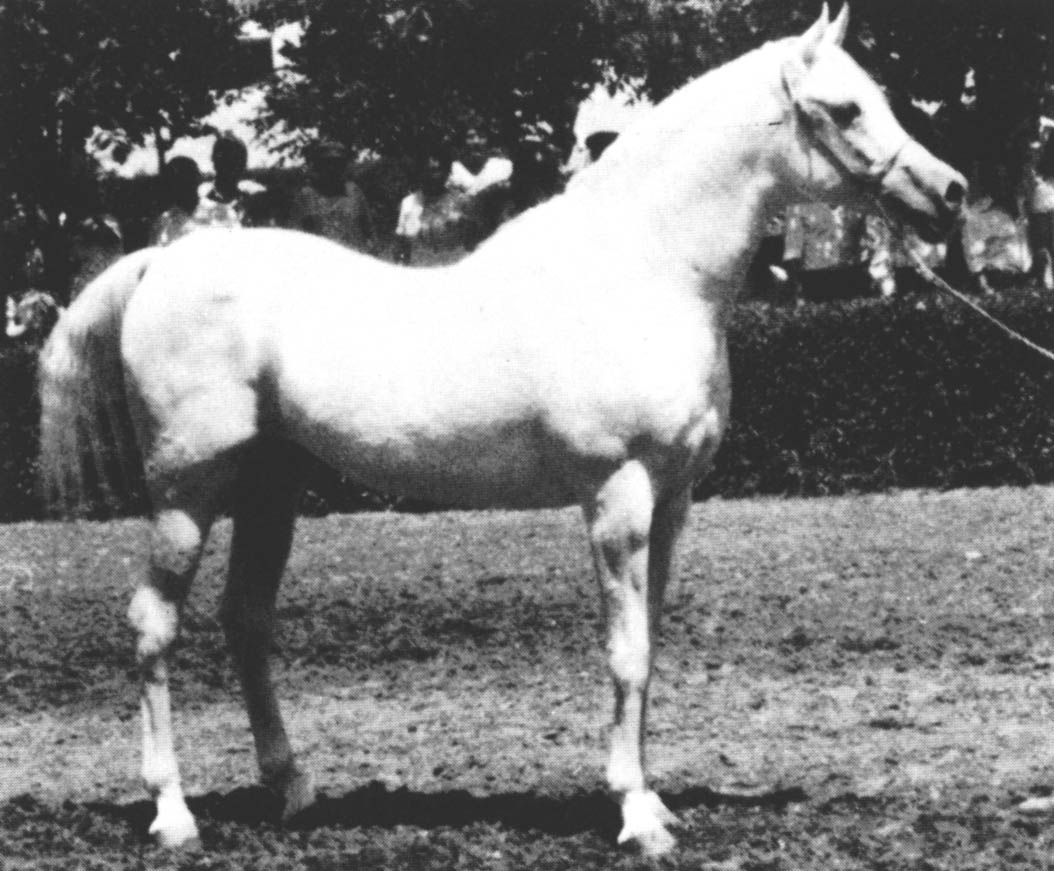
Aswan, (Nazeer x Yosreia) seven-eights brother
to his "classmate" Ansata Ibn Halima,
Aswan's role in Russia would make him one
of the leading sire lines in the world today.
Forbis archive.
Once more Nazeer would prove to be an impressive international influence when in March of 1958 an elegant colt was born and given the name Kaysoon [Kaisoon]. He would be exported to Germany and create a stir there for his unusual elegance and refinement for an Arabian stallion, which was not seen in Europe. It is interesting to note that because of his particular exotic type of elegance, it has been said that the general horse public did not know how to accept him. This fate was similar to the arrival of Morafic on U.S. shores who was also a very exotic horse like not ever before seen during their time. It should come as no surprise since genetically Morafic and Kaisoon were 87.5% related to each other. In time Kaisoon would prove his worth at stud and his blood is now much admired internationally.
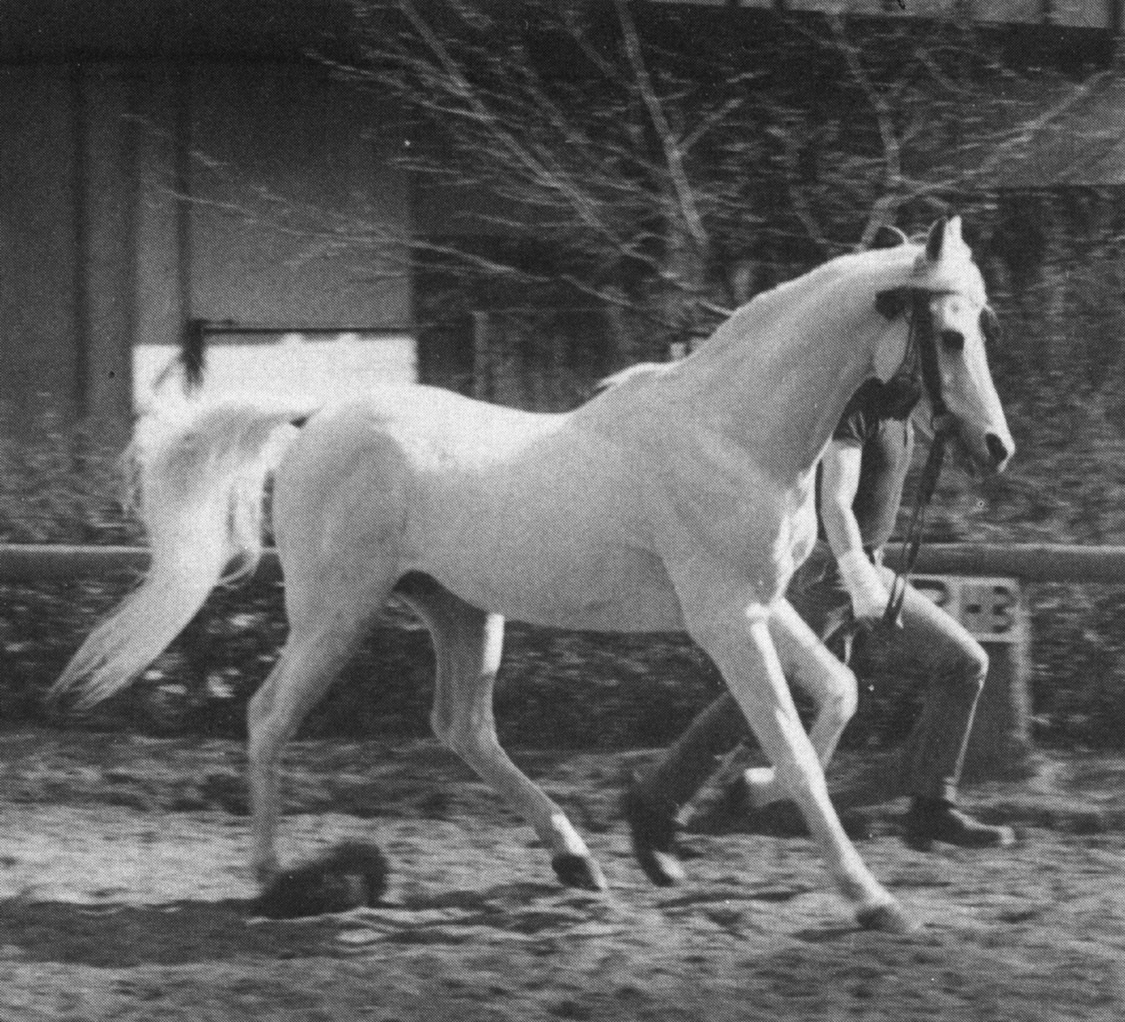
Kaisoon (Nazeer x Bint Kateefa)
his extreme refinement and elegance
was somewhat shocking to Europeans at the time
but he grew to become a very important sire.
Forbis archive.
A few more Nazeer sons were born in 1958, one in particular was the very beautiful Ibn Bukra (x Bukra) who raced well but died before being used. Nazeer's son Nader was foaled in 1958 and he also sired for AlBadeia stud but left only a few foals. However, Nader when bred to his companion Noha, also a product of the class of 1958, the result was the great broodmare Serenity Bint Noha. imported to North America by Hansi Melnyk. Nader also sired the influential German imported sire El Hilal GASB (x Ameena) whose daughter Bint Bint Basima established a family at Alfala Stud in the Kingdom of Saudi Arabia.
As the year of 1958 was drawing to a close, one more colt sired by Nazeer would be born in the fall. By anyone's standards he was a handsome dark steel grey foal of noted quality and marked by the most deep dark expressive eyes one can imagine. That special look stayed with him throughout his entire life and endeared many to him and led to the popular phrase "that Halima look". The colt's name in Egypt was Ibn Halima and he was exported as a yearling to the U.S., along with two fillies from the class of 1958, Bint Mabrouka and Bint Zaafarana all sired by Nazeer. These three yearlings became the foundation for the Ansata Arabian Stud.
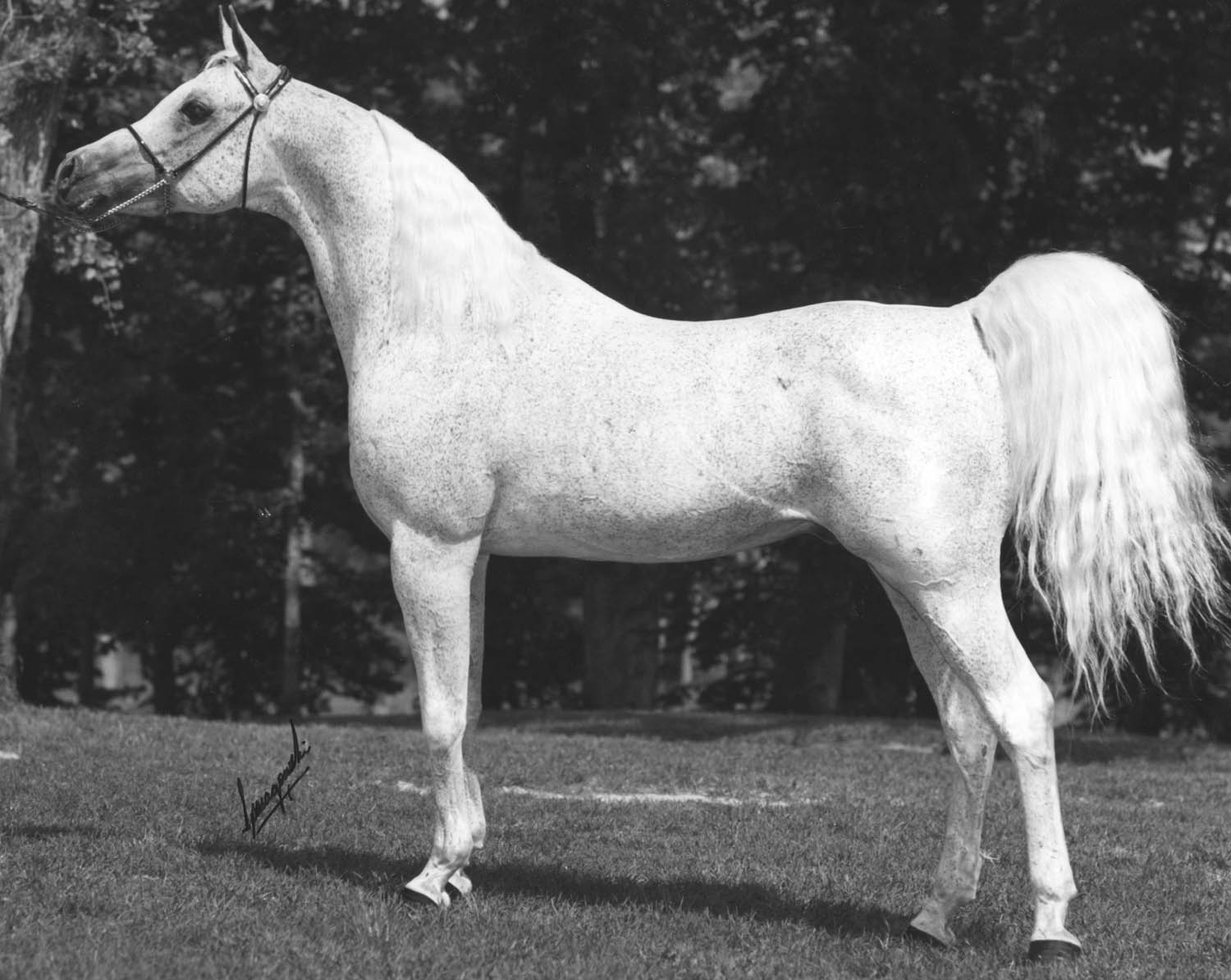
Ansata Ibn Halima (Nazeer x Halima)
the last born Nazeer son from the class of 1958
he would become one of the most beloved Arabians in America
and later a sought after name internationally.
Jerry Sparagowski photo.
If 1958 was Nazeer's year as described by the legacies of the above stallions, it is interesting to realize that of the 9 fillies sired by Nazeer in 1958, eight of them were used for breeding. Among these future queens were the aforementioned Ansata Bint Mabrouka and Ansata Bint Zaafarana. While Ansata Bint Mabrouka did not have a long life and left no daughters, all 3 of her sons are "hall of famers" with Ansata Ibn Sudan being U.S. National champion, and all 3 sons found in many international champions. Ansata Bint Zaafarana has both sons and daughters to represent her and is a part of the beloved Glorieta line so admired in the Arabian gulf region.
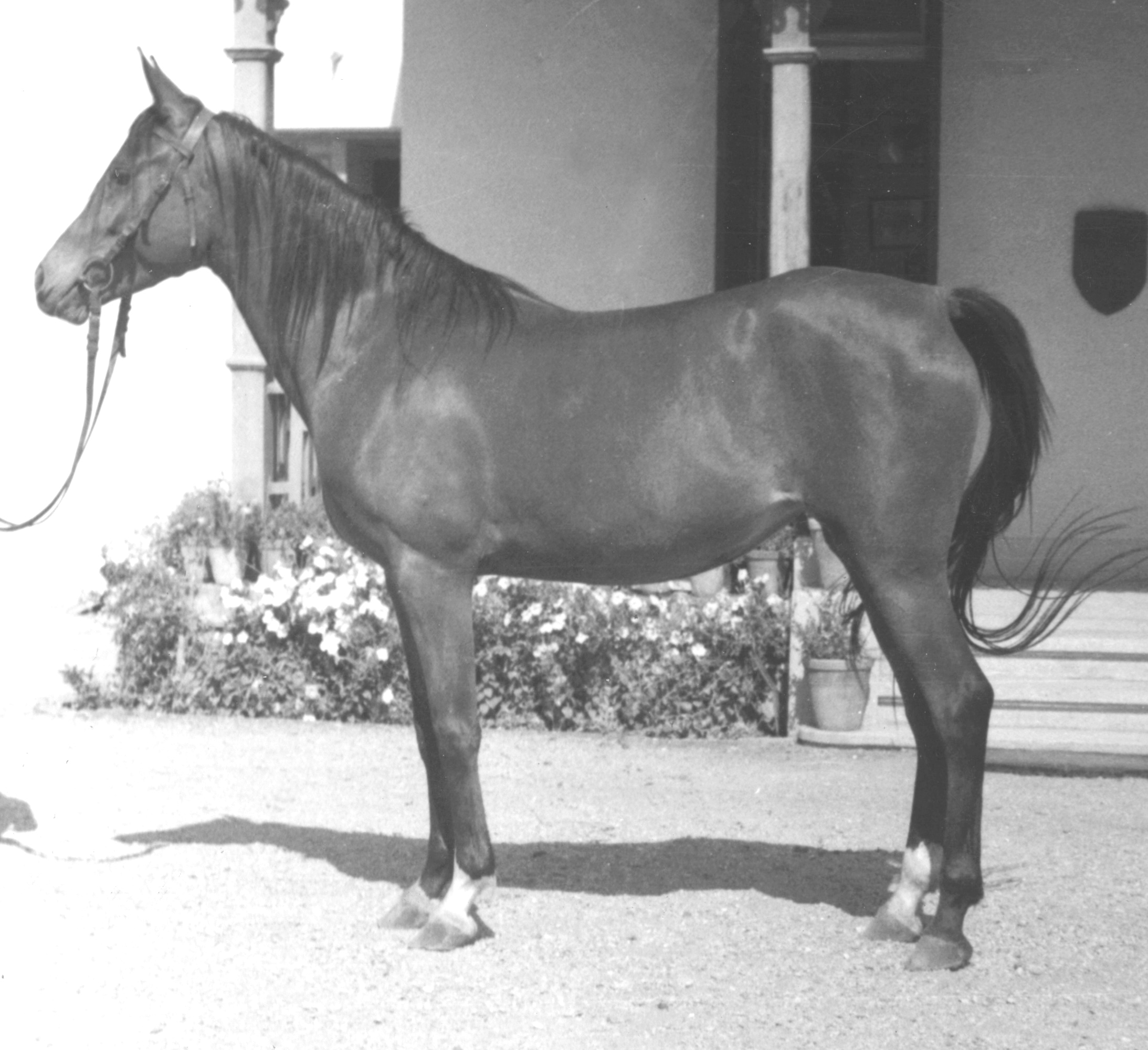
Bint Maisa El Saghira (Nazeer x Maisa) as a yearling in Egypt.
Like Bint Mona, she would become one of the most
globally influential mares largely via her son
Shaikh Al Badi, sire of Ruminaja Ali and many others.
Forbis photo.
Ansata Bint Mabrouka had a full sister in blood in the form of Bint Mona (Nazeer x Mouna). Bint Mona was also born in 1958 as was Bint Maisa El Saghira (Nazeer x Maisa) both being imported by the Marshalls of Gleannloch Farms. When one considers that Bint Mona produced The Egyptian Prince (x Morafic) and Bint Maisa El Saghira produced Shaikh Al Badi (x Morafic), the heavy use of both of these stallions and their being a part of the pedigree of Thee Desperado, the most heavily used straight Egyptian sire in the world, it is easy to see that just by this example Bint Mona and Bint Maisa Saghira have a huge impact worldwide on Arabian breeding.
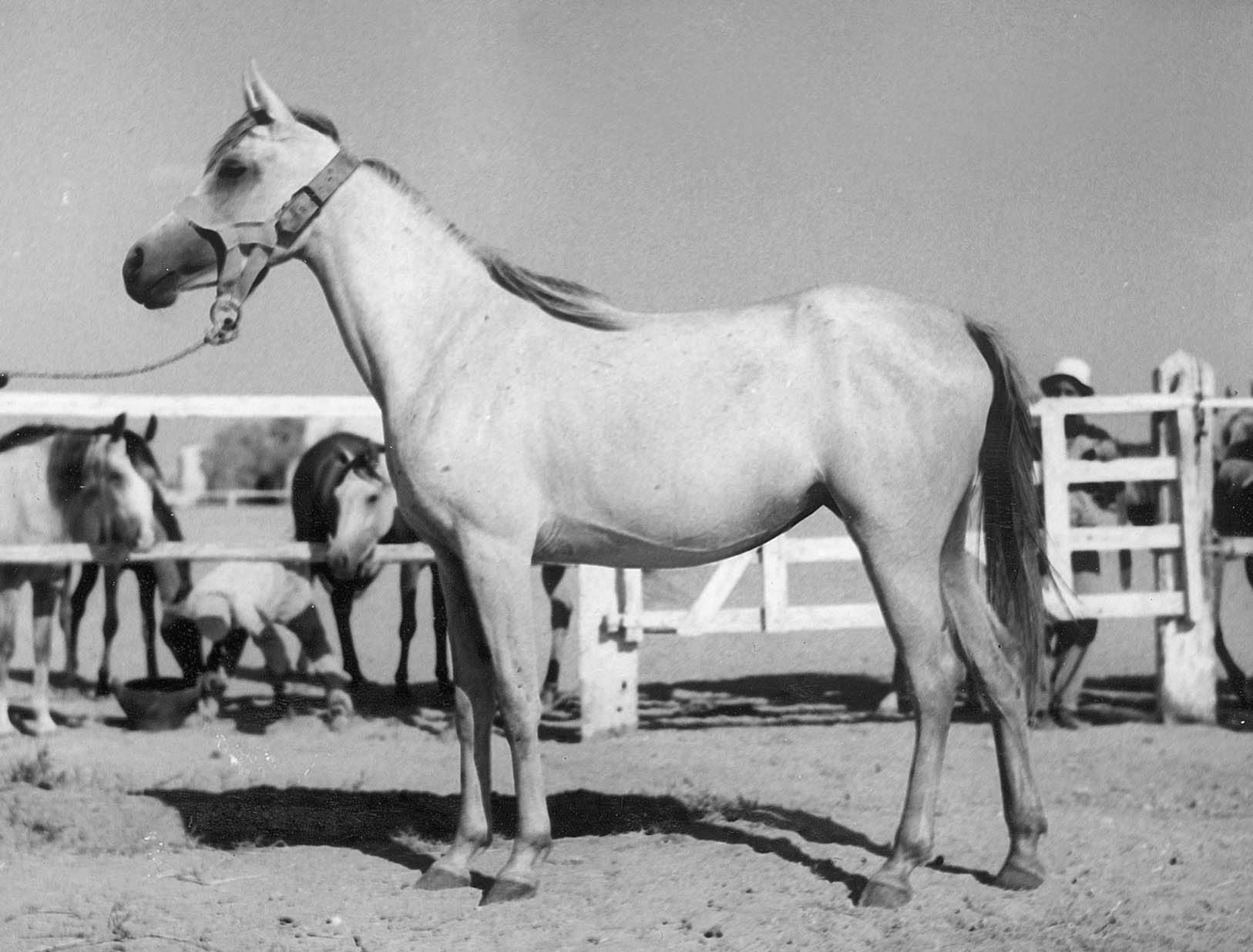
Bint Mona (Nazeer x Mouna)
as a yearling in Egypt already displaying her beauty
and charm which would put her in thousands of Arabian pedigrees
today largely through her son TheEgyptianPrince.
Forbis photo.
One final Nazeer daughter from the class of 1958 deserves special mention and that is the mare Bint Om El Saad who will be forever immortalized in her magnificent U.S. National Champion daughter Serenity Sonbolah (x Sameh). The role that Serenity Sonbolah would play in the Serenity breeding program, the Imperial breeding program and the Zichy Thyssen breeding program as well as others has assured her name in the rolls of great Arabian mares who have influence on the breed internationally.
We have talked about the class of 1958 from the EAO, but what about the two private breeders of that year, Hamdan Stud and AlBadeia Stud? As mentioned in the last newsletter, the Hamdan stud was building up its early herd from the 3 lovely Tahawi bred mares and again in 1958 each had a foal with Bint Barakat producing the stallion Baricat, Futna produced the mare Rhita, who was retained for breeding by Hamdan, and Folla produced Durra who went to the Police Academy for breeding.
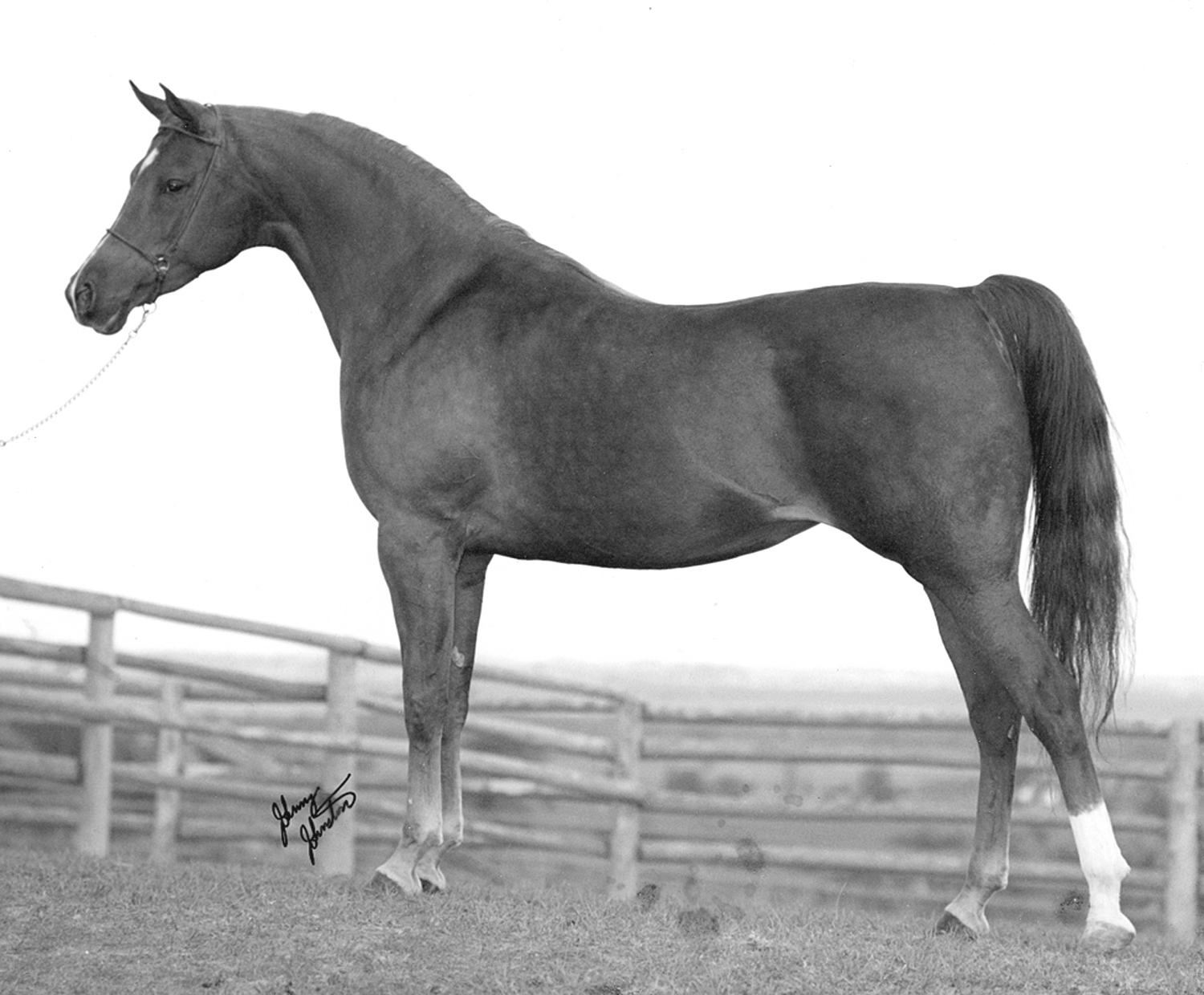
Serenity Sonbolah (Sameh x Bint Om El Saad),
this unforgettable U.S. National Champion mare
would be her mother's claim to fame making Bint Om El Saad
another important Nazeer daughter from the class of 1958.
Johnny Johnston photo.
AlBadeia Stud, as already mentioned would later be using a number of Nazeer sons from the class of 1958. As for horses produced in 1958 at AlBadeia, the stud bred its mare Zabia/Zobeya to the EAO stallion Gassir and got the filly El Aziza. She would eventually become a founding mare at Babolna in Europe and is famous as the female line of World Champion 218 Elf Layla Walayla B, who is the dam of muti-international champion El Nabila B. The other 1958 foal at Albadeia was the mare Bushra sired by Serenity Ibn Nazeer x Zahia. Bushra is found in numerous pedigrees of French bred Arabians today.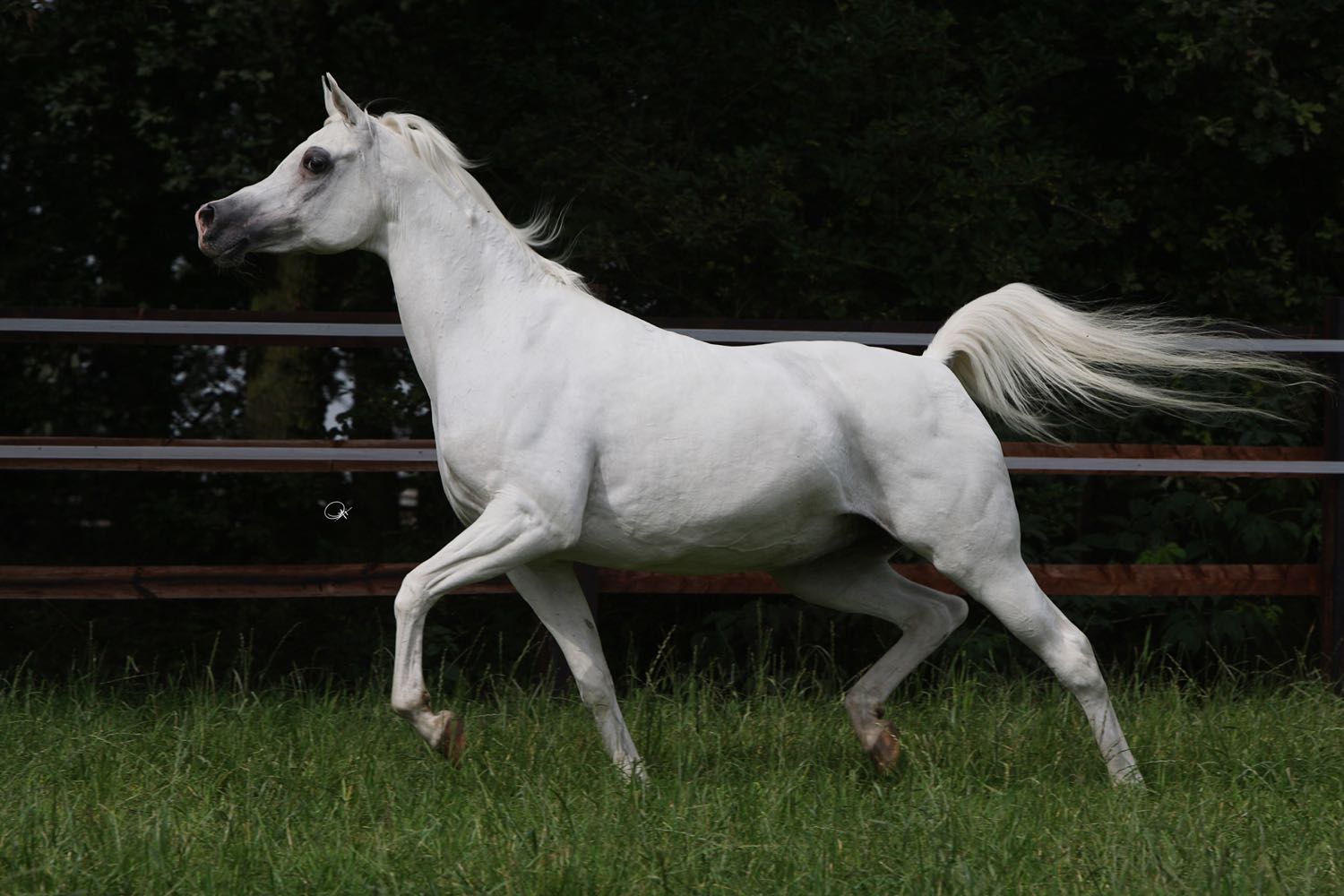
218 Elf Layla Walayla B,
a beautiful World Champion representative
of the 1958 AlBadeia bred mare El Aziza female line.
She is also dam of El Nabila B.
Gigi Grasso photo.
So all things considered even though fewer Arabian foals were produced in Egypt in 1958, that year will go down as one which was to produce many legends that are now a part of Arabian breeding worldwide. Just one example is Al Adeed Al Shaqab who is a product of four from the class of 1958, Ansata Ibn Halima, Ansata Bint Mabrouka, Bint Maisa El Saghira and Waseem. Even famed sires Marwan Al Shaqab and WH Justice benefit from the class of 1958 within their pedigrees. And there are many other examples making 1958 truly a year to remember.
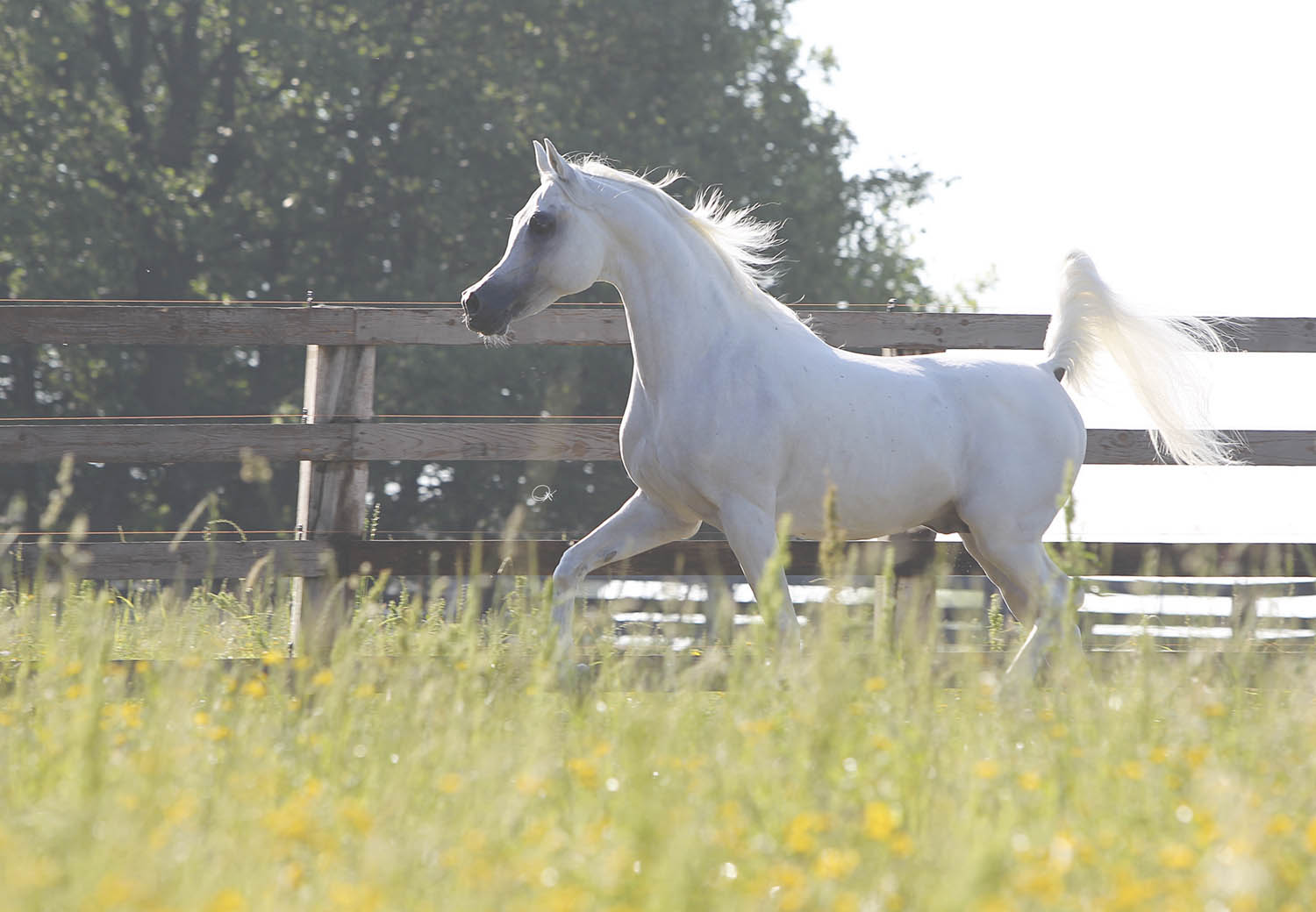
Al Adeed Al Shaqab,
world renowned sire who benefits from 4 of the class of 1958,
Ansata Ibn Halima, Ansata Bint Mabrouka,
Bint Maisa El Saghira and Waseem.
Gigi Grasso photo.




